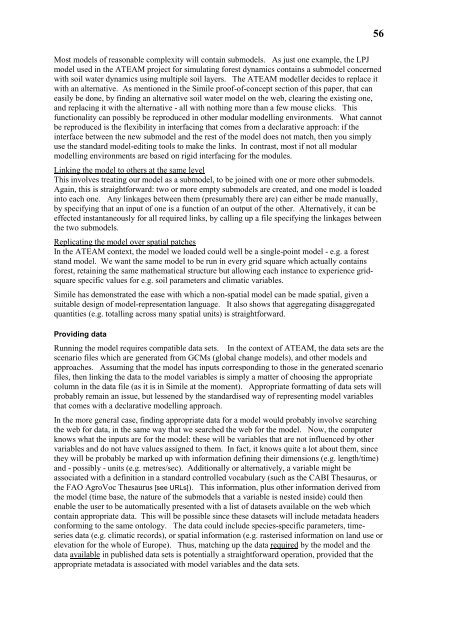pdf: 600KB - Potsdam Institute for Climate Impact Research
pdf: 600KB - Potsdam Institute for Climate Impact Research
pdf: 600KB - Potsdam Institute for Climate Impact Research
You also want an ePaper? Increase the reach of your titles
YUMPU automatically turns print PDFs into web optimized ePapers that Google loves.
56<br />
Most models of reasonable complexity will contain submodels. As just one example, the LPJ<br />
model used in the ATEAM project <strong>for</strong> simulating <strong>for</strong>est dynamics contains a submodel concerned<br />
with soil water dynamics using multiple soil layers. The ATEAM modeller decides to replace it<br />
with an alternative. As mentioned in the Simile proof-of-concept section of this paper, that can<br />
easily be done, by finding an alternative soil water model on the web, clearing the existing one,<br />
and replacing it with the alternative - all with nothing more than a few mouse clicks. This<br />
functionality can possibly be reproduced in other modular modelling environments. What cannot<br />
be reproduced is the flexibility in interfacing that comes from a declarative approach: if the<br />
interface between the new submodel and the rest of the model does not match, then you simply<br />
use the standard model-editing tools to make the links. In contrast, most if not all modular<br />
modelling environments are based on rigid interfacing <strong>for</strong> the modules.<br />
Linking the model to others at the same level<br />
This involves treating our model as a submodel, to be joined with one or more other submodels.<br />
Again, this is straight<strong>for</strong>ward: two or more empty submodels are created, and one model is loaded<br />
into each one. Any linkages between them (presumably there are) can either be made manually,<br />
by specifying that an input of one is a function of an output of the other. Alternatively, it can be<br />
effected instantaneously <strong>for</strong> all required links, by calling up a file specifying the linkages between<br />
the two submodels.<br />
Replicating the model over spatial patches<br />
In the ATEAM context, the model we loaded could well be a single-point model - e.g. a <strong>for</strong>est<br />
stand model. We want the same model to be run in every grid square which actually contains<br />
<strong>for</strong>est, retaining the same mathematical structure but allowing each instance to experience gridsquare<br />
specific values <strong>for</strong> e.g. soil parameters and climatic variables.<br />
Simile has demonstrated the ease with which a non-spatial model can be made spatial, given a<br />
suitable design of model-representation language. It also shows that aggregating disaggregated<br />
quantities (e.g. totalling across many spatial units) is straight<strong>for</strong>ward.<br />
Providing data<br />
Running the model requires compatible data sets. In the context of ATEAM, the data sets are the<br />
scenario files which are generated from GCMs (global change models), and other models and<br />
approaches. Assuming that the model has inputs corresponding to those in the generated scenario<br />
files, then linking the data to the model variables is simply a matter of choosing the appropriate<br />
column in the data file (as it is in Simile at the moment). Appropriate <strong>for</strong>matting of data sets will<br />
probably remain an issue, but lessened by the standardised way of representing model variables<br />
that comes with a declarative modelling approach.<br />
In the more general case, finding appropriate data <strong>for</strong> a model would probably involve searching<br />
the web <strong>for</strong> data, in the same way that we searched the web <strong>for</strong> the model. Now, the computer<br />
knows what the inputs are <strong>for</strong> the model: these will be variables that are not influenced by other<br />
variables and do not have values assigned to them. In fact, it knows quite a lot about them, since<br />
they will be probably be marked up with in<strong>for</strong>mation defining their dimensions (e.g. length/time)<br />
and - possibly - units (e.g. metres/sec). Additionally or alternatively, a variable might be<br />
associated with a definition in a standard controlled vocabulary (such as the CABI Thesaurus, or<br />
the FAO AgroVoc Thesaurus [see URLs]). This in<strong>for</strong>mation, plus other in<strong>for</strong>mation derived from<br />
the model (time base, the nature of the submodels that a variable is nested inside) could then<br />
enable the user to be automatically presented with a list of datasets available on the web which<br />
contain appropriate data. This will be possible since these datasets will include metadata headers<br />
con<strong>for</strong>ming to the same ontology. The data could include species-specific parameters, timeseries<br />
data (e.g. climatic records), or spatial in<strong>for</strong>mation (e.g. rasterised in<strong>for</strong>mation on land use or<br />
elevation <strong>for</strong> the whole of Europe). Thus, matching up the data required by the model and the<br />
data available in published data sets is potentially a straight<strong>for</strong>ward operation, provided that the<br />
appropriate metadata is associated with model variables and the data sets.
















